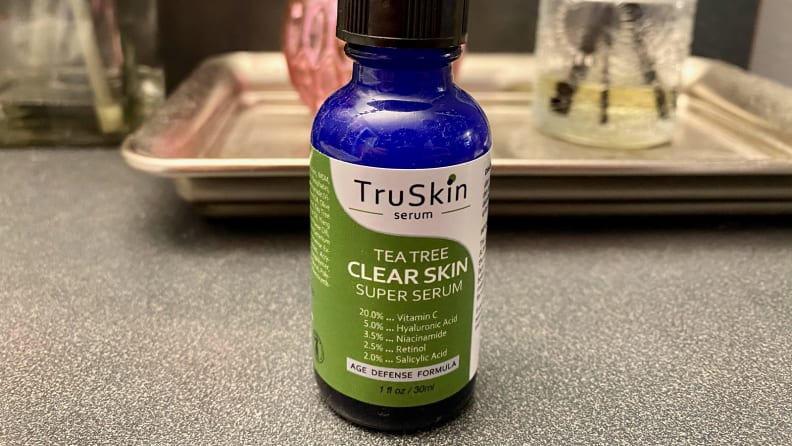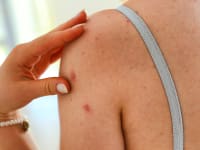Products are chosen independently by our editors. Purchases made through our links may earn us a commission.
Growing up, I dealt with on-and-off cystic acne. This type is considered to be one of the more severe forms of acne because it can cause infections to develop deep under the skin, leading to red, painful bumps. The blemishes often take weeks to resolve and makeup and skincare products can further aggravate them. While cystic acne can form anywhere on the face, mine tended to show up on my chin and jawline, making me self-conscious and frustrated in trying to manage breakouts. Even with makeup, it was still visible and I couldn’t hide it.
For nearly 10 years, between my teenage years and mid-20s, I tested every possible solution I came across to make my cystic acne go away. I tried prescription creams and salicylic acid and benzoyl peroxide face washes to no avail. I held hot compresses to my face for hours trying to reduce inflammation from the acne. I even booked laser appointments to have my skin zapped. Still, my cystic acne continued to creep back up with a vengeance.
Why did I try tea tree oil?
In the midst of uncontrollable breakouts that caused me serious discomfort, I browsed the internet for natural solutions that could alleviate my cystic acne. I came across a tea tree oil serum by TruSkin on Amazon that contains vitamin C and retinol. I figured my breakouts couldn’t get much worse and I hadn't tried tea tree oil-containing product on my skin before, so I decided to give it a shot. After a few days of using the serum every night before bed, I noticed that my cystic acne looked less and less inflamed each morning.
It took only a month or two for the cystic acne to be barely noticeable on my skin. I was thrilled to find a product that actually helped manage my breakouts. While it wasn’t a foolproof solution, it significantly decreased the amount of cystic acne I had and how severe the infections became. Rather than regularly dealing with cystic acne, it would happen a handful of times a year. To find out whether tea tree oil is a superstar acne fighter or if I just had great luck, I enlisted the help of Dr. Leonard Kerwin, a Michigan-based dermatologist with Associated Dermatologists.
What does tea tree oil claim to do?
Tea tree oil is considered to be effective in treating or alleviating a variety of skin conditions, including dry skin, eczema, dandruff, cuts, psoriasis, and, of course, cystic acne (among other types of acne). Because it has anti-inflammatory and antimicrobial properties, it’s thought to reduce redness, swelling, and inflammation. The particular TruSkin Tea Tree Clear Skin Serum that I used claimed to unclog pores, soothe aggravated skin, and improve skin tone. Because it includes vitamin C and retinol, it’s possible those ingredients may have contributed to my personal success using it.
Does tea tree oil do what it claims?

The TruSkin Tea Tree Clear Skin Serum claims to unclog pores, soothe aggravated skin, and improve skin tone.
In addition to its anti-inflammatory and antimicrobial properties, tea tree oil can be antifungal, antiviral, and antiprotozoal, meaning it’s helpful in treating viruses and skin infections.
However, you may not want to rely on tea tree oil as your only acne remedy. “It’s not regulated the same way by the FDA [as regulated treatments], so you have to be careful with that,” he explains. One example of why you should be cautious: Tea tree oil has a short shelf-life of less than a year. At that point, the properties of the oil can change, which can lead to adverse skin reactions, such as rashes and irritation, and at the very least, the product may no longer be effective.
What is it like to use tea tree oil on your skin?
About an hour before bed, I applied a dropper full of serum onto my hands and massaged it into my face each night to let the product sink in. My skin felt tingly after I applied the tea tree oil serum, similar to the feeling you get after brushing your teeth or from mint. My skin felt cool, fresh, and ultra-clean every time I applied the serum. Sometimes, if my skin was on the drier side or if I had any cuts, it would sting for a few minutes before dissipating. I enjoyed the scent, but some might find it overpowering because it runs on the stronger side. In the mornings, I washed it off and repeated this process again in the evening.
Are all tea tree oil products the same?
There are hundreds of tea tree oil products on the market designed for your skin, like the one I used. You can also use a tea tree essential oil if you dilute it with a carrier oil (like coconut oil) before applying it to the skin. I personally have had luck with using tea tree essential oil as a spot treatment for particularly stubborn acne, but it can cause skin irritation or rashes, so you may want to consult your dermatologist first.
There are also tea tree oil-containing face scrubs, washes, mists, and makeup removers. While no two tea tree oil products are the same, Kerwin recommends looking for a product that’s organic or USDA certified. You’ll also want to be wary of filler ingredients, such as parabens or dyes, which may or may not help your cause.
Is tea tree oil worth it as part of a skincare regimen?
Tea tree oil can be a valuable element of an overall skincare regimen, particularly for those with cystic acne. While more serious infections may benefit from prescription creams or antibiotics, tea tree oil can help with the redness and inflammation that may come with your acne. One way to check if tea tree oil might work for you is to do a spot test. Kerwin recommends leaving a bit of tea tree oil product on a patch of your skin, such as on your arm, for 24 to 48 hours to rule out any potential negative reactions. If your skin tolerates it, try it out for a few weeks to see if you notice any improvement.
While tea tree oil and the TruSkin Tea Tree Clear Skin Serum were particularly helpful for me in alleviating and managing my cystic acne, everyone’s skin is different and it may not work the same for you. Based on my experience alone, though, I give this product five stars for both its effectiveness and price (coming in at just under $25). If your skin sounds similar to mine or you’re interested in trying it, speak to your dermatologist to see if this solution might be right for you.
Get TruSkin Tea Tree Clear Skin Serum on Amazon for $24.79
The product experts at Reviewed have all your shopping needs covered. Follow Reviewed on Facebook, Twitter, and Instagram for the latest deals, product reviews, and more.
Prices were accurate at the time this article was published but may change over time.


